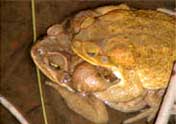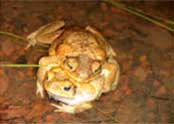

Get your Stop The Toad
bumper sticker here ..

Web Masters:
Use this button to
link back to this site.

CANE TOAD
This newsletter is available in pdf format here (350 kb) 48 hours in the field with frogwatch
Disappointment at lack of signage and informationAs part of our road trip we inspected all of the major 24 hour road stops between Broome and Katherine expecting some form of signage notifying travelers about the risks and dangers associated with cane toads and the need to be 'checking your load for toads'. We were of the understanding that some of the initially granted $600,000 was going to be contributed toward some form of public awareness but we have not seen any results along the highway. We were particularly disappointed that there was absolutely no information available at the Victoria River and Timber Creek Roadhouses where we expected at least some form of written information to be distributed. There was nothing! We have formally advised CALM and the Ministers office about our observations and are hoping that the signage problems will be overcome immediately as apparently a tender to supply and erect has been let. Plenty of signage, but no references between Katherine and Broome for the need to be on the lookout for cane toads. Set Your Traps ProperlyHAVE
TRAP, WILL CATCH! Once you have purchased your trap or installed it at your business there are a few things you need to do. The trap pictured is a bad example of how a trap can be set up that is not really toad friendly, or inviting. Traps work at night by the use of a UV light which attract insects and therefore attract hungry toads. The light needs to be in a position that will attract insects, and toads, into the middle of the trap (in other words concentrate the light into the trap), and ultimately should be battery/solar powered so that they don't rely on a person having to turn on a switch. Toads will push their way in through the one way door for a feed at night. Once in the trap these pests (that did not ask to come to Australia) should be provided with water and shelter to ensure their survival before they are humanely and quickly disposed of - not left to dehydrate in the harsh top end environment. A good idea is to partly cover the rear of the trap with shade cloth or roof insulation (see Frogwatch trap). Also make sure the entry doors are cleaned regularly-toad saliva attracts dirt and dust!
Traps should be set up with shelter for the caught toads. Chunky bits of wood bark, or half pvc pipe will provide shelter. Water should also be provided in shallow dishes. The traps can also be partly covered to protect from sun in the daylight. WA Government Commits!Most of you will have seen lots of toad talk in the news recently. Environment Minister Judy Edwards flew to Kununurra to spend time in and around Vic River and Timber Creek, which was shortly thereafter followed by an announcement by Geoff Gallop of another $1 million to the W A campaign. The great news is that $500,000 of this will be given to the Stop the Toad Foundation! We have asked Barry Haase to support our calls for the Federal Minister to honor his gov'ts financial support promises of last year (12 months ago!) and match the state govt commitments. We would expect an answer to Barry's letter in the near future from Ian Campbell.
Thanks to Graeme Sawyer at Frogwatch for taking the time to host us recently in the Northern Territory. It was an eye opener and we seriously recommend you contact Graeme if you'd like to spend some time in the field studying toads. Whilst at Ringwood Station we were treated to a fine demonstration of 'amplexus' at one of the billabongs where mating calls and doubling up was in full swing. In some cases four or five toads had attached themselves in 'amplexus' to a female toad. Frogwatch research suggests that generally males hover around the waters edge and the females avoid it where possible, preferring to hang back a little further into the bush habitat. No wonder, an innocent hop to the water to re-hydrate will most likely result in four or five horny toads climbing on her back in the hope of a successful mating. This also presents a great opportunity to eradicate multiple breeding toads
This
newsletter is produced by Russell Gueho and Vanessa Hayden
|
|||||||||
Supported by |
 |
Web Manager: Dave Graham - Web hosting & scripts: Alex Varlakov http://ozup.com/ |



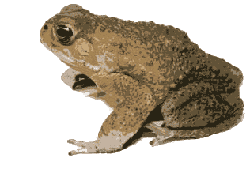
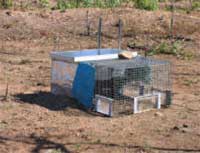
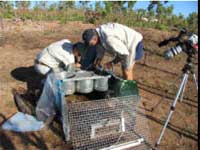
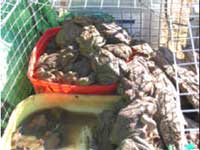
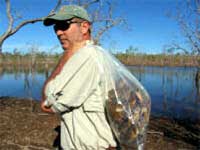
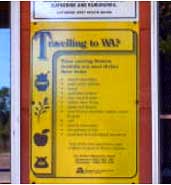
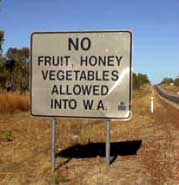
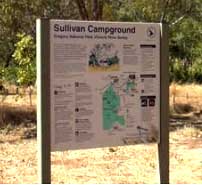
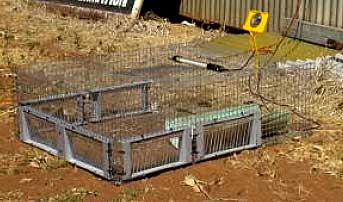
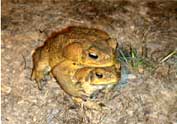 .
.
